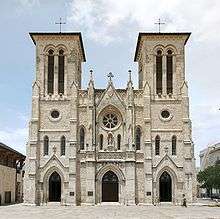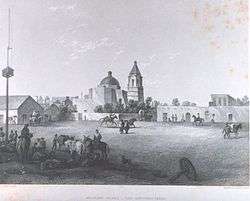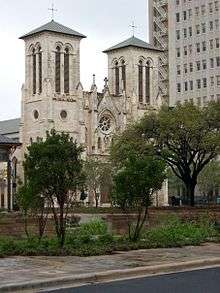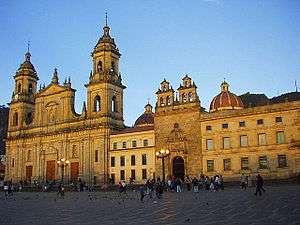Cathedral of San Fernando (San Antonio)
| San Fernando Cathedral | |
|---|---|
 San Fernando Cathedral is one of the oldest active cathedrals in the United States. | |
| Basic information | |
| Location | San Antonio, Texas, USA |
| Geographic coordinates | 29°25′27″N 98°29′39″W / 29.42417°N 98.49417°WCoordinates: 29°25′27″N 98°29′39″W / 29.42417°N 98.49417°W |
| Affiliation | Roman Catholic |
| Province | Archdiocese of San Antonio |
| Architectural description | |
| Architect(s) | Francois P. Giraud; Dielman,Leo |
| Architectural style | Colonial, Gothic Revival, Other |
| Groundbreaking | 1738 |
| Completed | 1868? |
| Official name: Church of Nuestra Senora de la Candelaria y Guadalupe | |
| Designated | February 25, 1975 |
| Reference no. | 75001949[1] |
| Governing Body | Private |
San Fernando Cathedral (also called the Cathedral of Our Lady of Candelaria and Guadalupe) is a cathedral of the Roman Catholic Church located in downtown San Antonio, Texas, USA. It is the mother church of the Archdiocese of San Antonio and the seat of its archbishop. The cathedral is also known as the Church of Nuestra Señora de la Candelaria y Guadalupe and is listed on the National Register of Historic Places. It is notable as one of the oldest cathedrals in the United States.
History


The original church of San Fernando was built between 1738 and 1750. The walls of that church today form the sanctuary of the cathedral, which gives rise to its claim as the oldest cathedral in the State of Texas. The church was named for Ferdinand III of Castile, who ruled in the 13th century. The baptismal font, believed to be a gift from Charles III, who became King of Spain from 1759, is the oldest piece of liturgical furnishing in the cathedral. The cathedral was built by settlers from the Canary Islands, for this reason the interior is a picture of the Virgin of Candelaria, the patroness of the Canary Islands.[2]
In 1836, the cathedral, still a parish church, played a role in the Battle of the Alamo when Mexican General Antonio López de Santa Anna hoisted a flag of "no quarter" from the church's tower, marking the beginning of the siege.[3]
In 1831, Jim Bowie married Ursula de Veramendi in San Fernando.
In 1868, under the director of architect Francois P. Giraud, the cathedral was considerably enlarged in the Gothic style, the addition forming the existing nave. The carved stone Stations of the Cross were added in 1874. The striking stained glass windows were added in 1920.[3]
On September 13, 1987, Pope John Paul II visited the cathedral during the only papal visit to Texas. A marker commemorates the event.
Today
The cathedral remains at the heart of Catholic religious life of San Antonio, and this includes involvement in annual events such as the Fiesta Week. Over 5,000 participate at weekend Masses each week of the year. Over 900 baptisms, 100 weddings, 100 funerals, and countless other services and special events are performed each year, most notably in the staging of the Good Friday Passion Play, which attracts thousands of visitors.
In February 2006, the cathedral began a year-long celebration recognizing San Antonio’s 275th Anniversary.
2003 major restoration
In 2003, a $15 million renovation project was undertaken which involved three phases:
- Phase One - restoration and stabilization of the cathedral foundation and structure and its enhancement for liturgy and other events. Among the changes, the altar was relocated to a movable platform closer to the center of the church to enhance the experience for Mass (the platform could be wheeled away for special events) and the baptismal font was relocated from the back of the church into the main aisle.[4]
- Phase Two - replacement of the rectory with a new Cathedral Centre which will house a small cafeteria, counseling rooms, museum, gift shop, reception room, television control room, and vesting sacristy.
- Phase Three - construction of a community centre to house community and social services, meeting rooms, a hall, church offices, and a residence for the priests.[5]
The 2003 renovation was supervised by Father Richard S. Vosko, a liturgical design consultant and priest of the Diocese of Albany who has overseen the redesign and renovation of numerous churches and cathedrals around the country.[6]
2011 minor renovation

In 2011, Archbishop Gustavo García-Siller, broke from the design envisioned for the cathedral restoration and reversed some prior alterations, unveiling a new altar (permanently affixed to the floor closer to the sanctuary and made of stone from Spain, Turkey and Israel); a new traditional bishop's chair or cathedra (crafted of white oak and resting on an extended sanctuary floor made of tile); relocating the baptismal font from the back of the church back to the front next to the lectern (opening up space for processions into the church from Main Plaza); and installing a new railing behind the altar to section off the sanctuary (to prevent people visiting the retablo from straying onto the altar). Donations from parishioners and outside donors in the amount of $150,000 funded the 2011 project.[5] As part of the dedication, the archbishop placed three relics in the altar. Two are relics of St. Anthony of Padua, a Doctor of the Church and the patron saint of San Antonio; and a third relic is of Venerable Concepcion Cabrera de Armida, also known as Conchita, who inspired the formation of the Missionaries of the Holy Spirit (Archbishop Garcia-Siller was ordained a priest to the Missionaries of the Holy Spirit in 1984) as well as 16 other spirituality inspired Catholic organizations.[4]
See also
- San Antonio Missions National Historical Park
- Alamo Mission in San Antonio
- Alamo Plaza Historic District
- Main and Military Plazas Historic District
- List of the oldest churches in the United States
References
- ↑ National Park Service (2008-04-15). "National Register Information System". National Register of Historic Places. National Park Service.
- ↑ "Conoce Candelaria" [Meet Candelaria] (in Spanish). Town of Candelaria. Retrieved 2016-03-04.
- 1 2 Gaines, Ann Graham (June 15, 2010). "San Fernando Cathedral". Handbook of Texas Online. Texas State Historical Association. Retrieved March 4, 2016.
- 1 2 Levy, Abe (November 18, 2011). "Archbishop dedicates new San Fernando altar". San Antonio Express. Retrieved March 4, 2016.
- 1 2 "272-Year-Old San Fernando Cathedral Celebrates Historic Restoration; Cathedral unveils 18th Century style retablo at Dedication Ceremony" (Press release). Historical Centre Foundation. March 29, 2003. Retrieved March 4, 2016.
- ↑ "Cathedral of San Fernando". Richard S. Vosko. Retrieved March 4, 2016.
External links

- Official cathedral site
- Roman Catholic Archdiocese of San Antonio
- National Register of Historic Places.com
- San Fernando Cathedral at the Handbook of Texas Online
